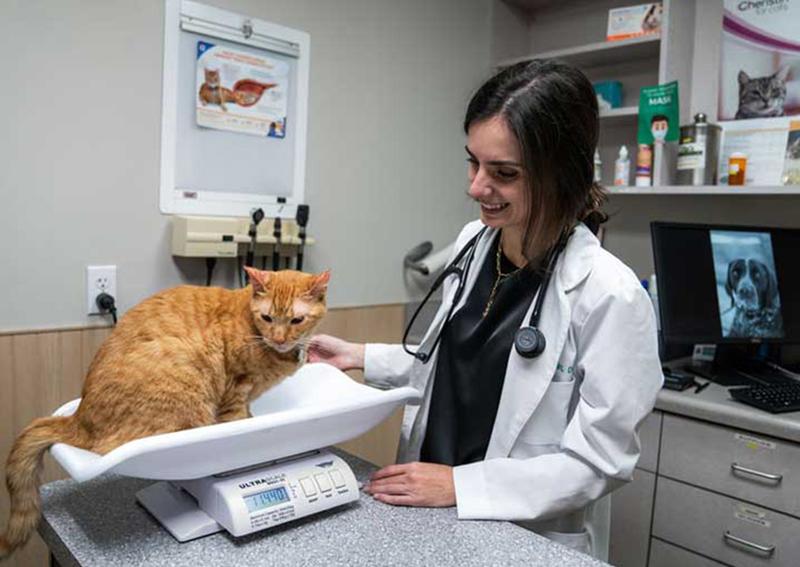Intestinal Parasites in Cats
Intestinal parasite control is a mainstay of effective cat preventive care. And testing for internal parasites is a cornerstone of our routine wellness exams. If infected with parasites, your cat has treatment and preventative options available at our sister practices. But what are intestinal parasites in cats?
Prevalent intestinal parasites in cats are worms and protozoans (microscopic, non-worm parasites). The more common internal parasites are hookworms, roundworms, and tapeworms. Non-worm parasites common to cats are coccidia, giardia, and toxoplasma.
If parasitic infections are left untreated, problems can arise in the health of your cat, including digestive complications, anemia, and immune deficiency. Kittens, more than adult cats, are particularly vulnerable because of their weaker immune responses. Here is what you need to know to help your cat be parasite free.
Intestinal Worms that Infect Cats
Intestinal worms infest and live inside a feline’s intestinal tract. Most cats—95 percent—are born already infected with intestinal worms, which they “inherit” from their mothers. An entire litter of kittens may acquire worm larvae through their mother’s milk if she is infected. When adult cats have worms, it may be that they have carried the parasites for their entire lives.
Cause and Symptoms
Adult cats may gain new parasites, especially if they have fleas or if they hunt rodents that themselves have worm larvae within their tissues. Yet, there is a more common source of intestinal worm infection in cats, young or old. Worm eggs can survive for some time in the waste, or waste-contaminated soil, of other (infected) cats. Healthy cats can pick up those eggs simply by making contact with the waste or soil.
There are a few species of intestinal worms that are common to cats: hookworm, roundworm and tapeworm. Although a bit different in size and shape, there are some symptoms that one or all species may exhibit when they infect a cat.
- Lethargy
- Poor coat
- Loss of weight
- Extended abdomen
- Vomiting
- Diarrhea
- Bloody stool
- Worms, or worm fragments, in the stool or around the anus
- (Many cats display no symptoms at all)
It’s important to note, however, that many cats are asymptomatic for intestinal parasites. Meaning a cat can spread a worm infection that the pet parent isn’t even aware of. Reasons like this are why regular exams by your veterinarian are vital.
Hookworm
Hookworms grow in length to about one-half to one inch. They are white or pale yellow. The Ancylostoma braziliense and Ancylostoma tubaeforme species of hookworm are very common in cats, as well as a species that often infects dogs, Ancylostoma caninum.
Cause. Cats can contract hookworm infection from making contact with, or eating, infected animals or their waste. Kittens can acquire worms from their mothers through the uterus or milk. Cats can even contract hookworms via their grooming habits when they lick their paws after walking on contaminated soil or surfaces. Another way cats can get hookworms is through the skin, mainly through the feet.
Symptoms. Hookworms can burrow through the skin which may result in irritation and secondary infection. Because they attach themselves to the internal lining of the small intestines and feed on blood, hookworms can cause anemia. At the same time, many cats may show no signs of hookworm infection. To summarize, symptoms of hookworm infection can include:
- Skin infection
- Loss of weight
- Poor coat
- Bloody stool
- Diarrhea, which may also contain blood
- Anemia
- (No symptoms at all)
Roundworm
Roundworms are the most common of the three intestinal worms discussed on this page. Unfortunately, almost all cats are either born with roundworms or acquire them soon after birth. A serious roundworm infection, with its symptoms, is called ascariasis.
Toxocara cati and Toxacaris learning are the two common species of roundworm found in cats. Roundworms grow up to 2 or 3 inches in length and resemble short strands of cooked spaghetti. Rather than attach themselves to the intestinal lining to feed on blood, they roam freely within the intestinal tract and eat food remnants.
Cause. Transmission of roundworms happens most often when a cat ingests worm eggs or larvae that are 1) passed through the waste of infected animals, or 2) found in the cat’s prey, such as birds, rats, and roaches. Dormant roundworm larvae can activate after several years and grow into adults. Pregnant cats can pass the parasites to their unborn kittens, or later through nursing.
Symptoms. When kittens contract roundworms, they can suffer poor development and their growth can even be stunted. These parasites can cause lethargy, excessive gas, weight loss, diarrhea, and vomiting. Since the worms often form themselves into balls, they can cause intestinal blockage. A pot belly is another common symptom of roundworm infection.
- Lethargy
- Gas
- Poor growth
- Bloated abdomen
- Loss of weight
- Diarrhea
- Vomiting
- (No symptoms at all)
You may notice no symptoms at all in cats with roundworms. However, you may see worm eggs or larvae in an infected cat’s waste or around the anus. Since humans can contract roundworms (but rarely develop symptoms) it is important to protect, not only your cat but your entire household from these parasites.
Tapeworm
Tapeworms reside in the small intestines and attach themselves to the interior wall. They grow in small segments that chain together and look like grains of rice when they break away from the larger chain. Segments (also called proglottids) may contain tapeworm eggs.
Cause. Typically, cats acquire the tapeworms by eating (intentionally or otherwise) the intermediate host. Echinococcus is zoonotic, which means humans can acquire these species of tapeworms and pass them to cats. Outdoor cats who hunt and eat prey typically acquire Taenia worms. Since the usual host of Dipylidium is the flea, pet owners can help prevent the spread of this species of tapeworm through flea prevention.
Symptoms. While adult cats may suffer few symptoms of tapeworm infection, kittens can suffer stunted growth, an upset digestive tract, and intestinal blockage if a large number of worms accumulate. Other symptoms of tapeworms are poor coat, abdominal bloating, diarrhea, and vomiting if worms have moved into the stomach.
- Loss of weight
- Poor growth
- Poor coat
- Bloating
- Digestive upset
- Diarrhea
- Vomiting, which may include worm segments
- (No symptoms at all)
Worm segments may also be seen around an infected cat’s rectum or in its waste. On the other hand, cats with a tapeworm infection may display no symptoms.
Non-Worm Parasites that Infect Cats
Intestinal parasites are not limited to worms. Microscopic single-cell organisms, or protozoa, can also infect cats as parasitic problem-makers. They reside mainly in the intestinal tracts of both adult cats and their kittens.
Kittens especially can suffer from Giardia and Coccidia, as these can cause severe digestive issues in the young. General symptoms include:
- Only partial digestion of food
- Loss of appetite and/or weight
- Dehydration
- Diarrhea
- Vomiting
- Blood and/or mucus in the stool
- Inflammation around the anus
- (No symptoms at all)
Coccidia
Coccidia in cats (Isospora felis and Isospora rivolta) can spread to kittens from their mothers. Cats may consume contaminated droppings of mice, rats, rabbits, or other animals. Coccidia, in the form of cysts laying on the ground or within prey, may also be consumed when feeding. Infection by this parasite is called coccidiosis.
Coccidiosis is most commonly indicated by loss of appetite, dehydration, diarrhea, and vomiting. These symptoms typically occur in kittens and adult cats with immune deficiencies, while other cats may display no symptoms at all.
Only a veterinarian can diagnose Coccidia infection by examining a stool sample, as the required testing is very comprehensive. If diagnosed, the vet will prescribe an anti-parasitic and, if necessary, recommend extended treatment.
Giardia
Giardia (duodenalis) attach themselves to the interior of the small intestines. Humans can contract them from their pets, and vice versa. An infection can cause diarrhea and vomiting in owners and their cats. The infection is called giardiasis.
Giardia, in cyst form, is acquired by cats when they consume prey or the waste of other infected animals. In addition to the symptoms listed above, cats may also develop fever and eliminate stool that is green and/or very wet.
Toxoplasma
While the protozoa can proliferate among cats, symptoms of Toxoplasma (gondii) infection are more likely to occur in cats with compromised immune systems. If Toxoplasma moves into the lungs or liver, a cat may develop pneumonia or jaundice, as the case may be.
Humans can be infected with Toxoplasma. This infection can occur via contact with an infected cat, specifically by coming into contact with contaminated stool from the litter box, fur, etc. However, this is not the most common source of infection in people. Humans are much more likely to contract toxoplasmosis via handling fresh, raw meat, or by coming into contact with contaminated soil during gardening, etc.
For more information on how our practice can help defeat these illnesses, contact us today.

